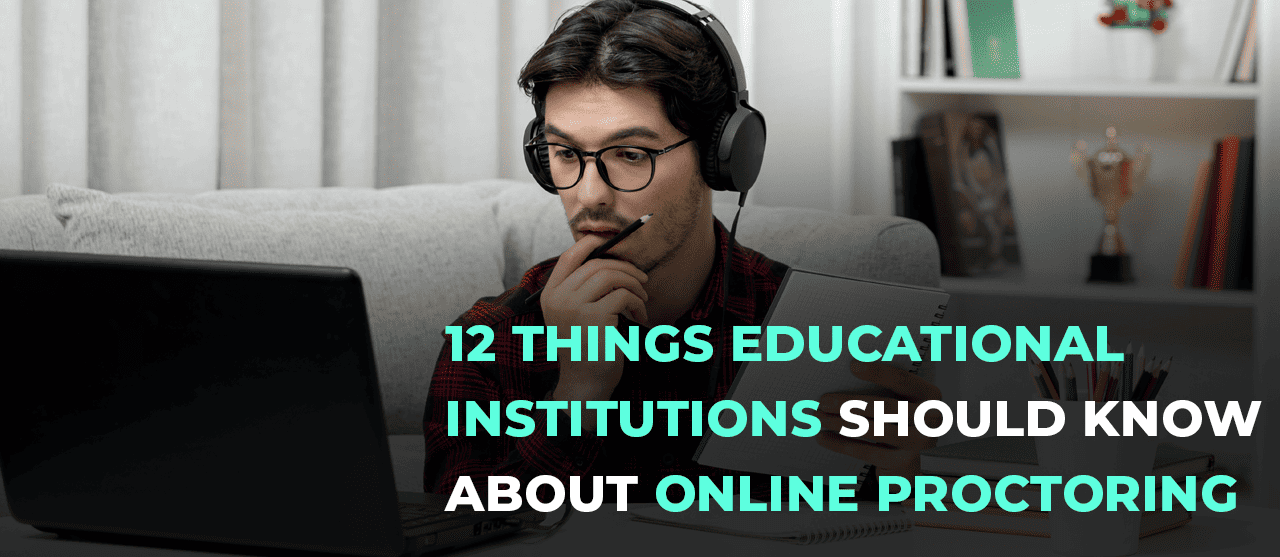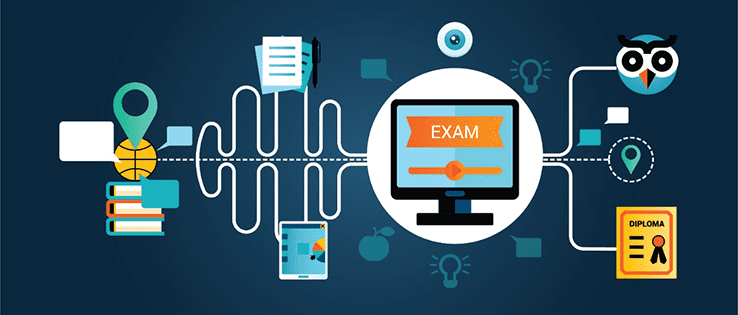
As a result of the ongoing pandemic, educational institutions have migrated a significant number of their courses to an online mode. Digital technologies have largely enabled this transition from physical to virtual classrooms. This shift to online learning has also necessitated a significant increase in online examinations and assessments.
To conduct online exams, educational institutions and universities are using online (or remote) proctoring tools to ensure they are fair and ethical. As with every new approach, there are myths and confusion surrounding online proctoring. Below, we answer 12 key questions that every educational institution should be asking about online proctoring before adopting this practice.
1. What is Online or Remote Proctoring?
Online proctoring is what enables students to take their examinations from any remote location without having to travel to an examination center. Proctoring tools like webcams and audio devices are used to confirm the student’s identity and maintain the integrity of their online exam. Remote proctoring sometimes involves human invigilators administering online exams to ensure a cheating-free environment.
2. How does Online Proctoring Work?
Online proctoring is enabled by various proctoring tools that can authenticate the student’s identity and monitor their online exam session. For instance, proctoring tools can determine the student’s identification using biometric methods like face recognition or retinal scanning. Such online proctoring tools can also track “suspicious” student actions like leaving the immediate exam area or certain head and eye movements.
3. Why is Online Proctoring Necessary?
For certain online courses, it is essential to assess the students to ensure they understand the subject matter. The COVID pandemic and resulting lockdown-related restrictions make it challenging for students and exam invigilators to physically travel to exam centers. Online proctoring is an easy-to-use and effective way of evaluating students using monitored exams and provides a sufficient deterrent against student misconduct.
4. What are The Various Types of Online Proctoring?
There are primarily three types of online proctoring, namely:
- Live Proctoring where a remote proctor is live and continuously proctoring the exam and the student in real-time during the online exam session.
- Recorded Proctoring where proctors review recorded online exams using session recordings, screenshots, and log data after the online exam has been completed.
- Automatic Proctoring where online proctoring is conducted using automated proctoring tools or software without a human proctor.
5. What are The Advantages of Online Proctoring?
As a result of current pandemic restrictions, online proctoring offers multiple advantages for educational institutions. Online exams typically cost less to administer than conducting examinations at physical exam centers. In addition, online proctoring enables institutions to conduct “virtual” exams with proctors and students participating from practically anywhere in the world. Students and proctors also benefit from the convenience of not traveling to an examination hall, all while maintaining the integrity of the exam.
6. What are The Disadvantages of Online Proctoring?
While online proctoring has its advantages, it also has its share of a few disadvantages. One such disadvantage is that students may feel that the proctoring software is intrusive and an invasion of their privacy. In addition, the presence of an online proctor or constant exam monitoring may make some students uncomfortable and increase their stress levels.
7. How does Online Proctoring Prevent Students from Cheating?
There are multiple ways that students cheat during online exams, including impersonating, screen-sharing, searching online, and using mobile phones or hidden microphones.
Proctoring methodologies can reduce student misconduct by:
- Validating student’s identity using cameras and biometrics
- Disabling online search and screen-sharing functionalities on the student’s browser
- Timing out exam sessions automatically due to prolonged inactivity
8. What Technologies are Used to Enable Online Proctoring?
Online proctoring technologies depend upon the type of proctoring that is being deployed. For example, live proctoring cannot be implemented with an internet-connected webcam. Automated proctoring requires Artificial Intelligence (AI) tools to detect and report suspicious behavior. Similarly, recorded proctoring requires technologies that enable screen-sharing, session recording, and audio-video feeds of the online exam.
9. What is Driving the Popularity of Online Proctoring?
In the COVID era, there is an increasing demand for online learning (eLearning) and distance education. Online proctoring eliminates the constraints of “traditional” exam proctoring that occurs in an examination hall or specific physical location. Further, with cost-effective online proctoring tools and services, educational institutions are able to save the money they would otherwise spend conducting in-person exams.
10. What are The Must-dos for Conducting an Online Proctored Exam?
To conduct a successful exam using online proctoring, educational institutions must ensure that:
- Students are taking the online exam on their desktop or laptop computers with a specified minimum configuration
- Students are using desktop or laptop computers with all of the required proctoring tools installed and configured
- Students are sitting in a well-lit and quiet room for the duration of the exam
- Students are alone in the room for the duration of the exam
11. What Must be Avoided when Conducting an Online Proctored Exam?
To conduct a successful exam using online proctoring, educational institutions must ensure their students avoid:
- Moving away from their computer or laptop during the exam session
- Using any other external device like a mobile phone or microphone
- Speaking to any other person during the exam
12. What is The Future of Online Proctoring?
Thanks to its many benefits, online proctoring is now being used by public and private educational institutions around the world. Moving forward, remote proctoring will continue to be an integral part of online learning. Existing tools like facial and speech recognition and keyboard analysis will likely be leveraged even more to support successful online proctoring. In the future, proctoring technologies may even advance to include applications that leverage connected devices like smartwatches and fitness monitors.
Conclusion
The COVID-19 pandemic has accelerated the shift toward online education. As a result, online or remote proctoring is here to stay. At EnFuse Solutions, we have enabled universities and educational institutions to cope with COVID-related challenges with our online proctoring solutions. If your organization wants to explore the possibilities of online courses and exams, contact us now to learn more.
Leave a Reply
Your email address will not be published. Required fields are marked *


















Comment